I’ve recently discovered a blog that looks fantastic: it’s called Home Made Labor (more to come on blogs and websites about new media art and interaction design i’ve discovered in 2006), written in german and just waits to be added to your feeds if -unlike me- you’re happy enough to understand the language. That’s where i stumbled upon Game Arcade.
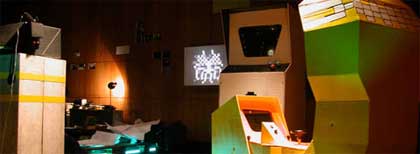 Game Arcade consists of four game machines which reproduce interactive game surfaces known from the digital world with the help of solely analogue and/or mechanical projectors. Inside are modified 8mm-film- and slide projectors. The game surfaces are created on 8mm-film and projected as film-loops. The interaction or navigation happens mechanically or by buttons and switches. Speakers play a soundtrack and alarm sounds while playing.
Game Arcade consists of four game machines which reproduce interactive game surfaces known from the digital world with the help of solely analogue and/or mechanical projectors. Inside are modified 8mm-film- and slide projectors. The game surfaces are created on 8mm-film and projected as film-loops. The interaction or navigation happens mechanically or by buttons and switches. Speakers play a soundtrack and alarm sounds while playing.
The installation, developed by mobileskino (Florian Olloz, Roland Schmidt, Gilbert Engelhard and David Pfluger) looked so interesting that i asked the guys to tell me more about it.
David Pfluger was kind enough to answer my questions:
Can you gives more details about the Game Arcade?
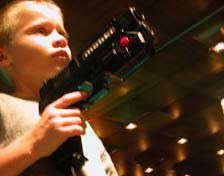 The Game Arcade is a set of machines which resemble ’80s style video games.
The Game Arcade is a set of machines which resemble ’80s style video games.
Still there is a big difference with video or compuer games as our machines work without any digital technology at all. What can be seen on the screens are slide and super8 projections. But the Games the machines represent can actually be played. There is a racing game (Racer), a shooting game (8-Box/Shoot the Monster), a slot machine (Pixel Slot) and a game in the style of the LCD handheld games from the ’80s (before Game Boy), the Pixelblaster. The technology to drive the games are sensor driven relais, some timer switches and mechanically changed Super8 and slide projectors.
All the exterior casing is made of cardboard.
How do Racer and PIXELBLASTER work exactly?
The Racer is a classic car racing game where you sit on a seat and use a small wheel to drive a car through landscape whithout getting off the track. If you get off the road whith just one wheel an alarm sound rings, if you go off the road completely you crash and the game stops. The car is made from cardboard and driven mechanically by the wheel. It lies above a screen where the road appears as a back projection from a Super8 projector playing the “road film” in a loop. The speed of the projectors motor and thus the speed of the game can be changed. Light sensors fixed underneath the car detect if the car is on or off the road.
The Pixelblaster is a skill game. The player is a figure which can be moved horizontally between four differennt positions by a hand control unit. Above the figure is a panel of 4×6 “pixels”. The panel is made from cardboard boxes with cut out shapes which are lit from the inside. This panel shows objects falling down towards the figure below. The player has to jump away so he will not be hit by the falling objects/lights. The figure of the player is a side projection onto the lower part of the screen. The system will recognise if the figure is hit by a faling light.
The “brain” of the machine which drives the lights on the panel is a Super8 projector which projects onto a small screen equipped with light sensors. The film projected is an animation film with black squares moving around. The light sensors detect the dark and light areas being projected and will switch the lights of the panel on or off accordingly.
Consequently the way the lights fall down is driven by the film which is projected. The Super8 projector used is a loop cartridge projector. Like this it is possible to exchange cartridges and have a different game each time (game cartridges). The projected Super8 image itself is not seen by the player it just serves to transmit the information for the screen. Super8 as a punchcard type data storage.
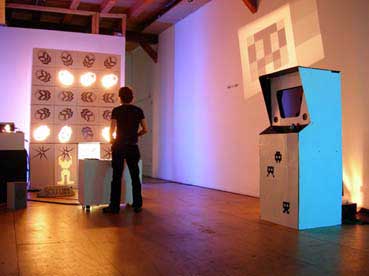 Pixelblaster on the left and Pixel Slot Machine on the righ
Pixelblaster on the left and Pixel Slot Machine on the righ
What inspired you to create The Game Arcade?
mobiles kino is a group of four Super8 ethousiasts. Working with Super8 we are often confronted with the tension between “modern media” and what is seen as retro or just old. Many people have the idea that a more modern product (video) is necessarily better than an older one (film). This is what the industry wants to make us believe as they want to sell their new products. We see differently. Each technology has its own characteristics which makes it artistically unique. If you choose to express yourself you will not just take the first media which you get your hands on or the most modern one, but choose the medium according to what you want to say or to harmonize with your artistic language. Painters still use oil painting even though there is Photoshop. Older and newer media should not be in concurrence against each other as all of them have their specific advantages which can be what you are looking for.
The Game Arcade is our artistic answer to the discourse about analogue and digital. Digital media are often used to imitate or simulate things from our analogue world (like the weather etc.). In the Game Arcade we simulate digital Games with analogue technology.
The initial idea was from Florian and Roland who wanted to make a slot machine type installation with Super8 projections. At first it was not clear if this was to become something interactive. Talking about the project we liked the idea more and more and widened it out. In the following years we built the existing machines and continuously updated them to make them more playable and visually exciting.
Can you explain us what HIGH NOON is about?
The installation High Noon is our latest addition to our game machines. It goes a step further than the others. With this project we attach an analogue machine to the cyber world of cell phones. The game is simly a duel. Two cowboys are projected facing each other onto two screens opposite to each other. They are waiting to duel. The projections are Super8 loops.
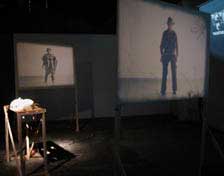
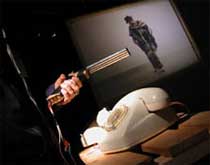
There are two playing modes:
1. Two players come and attach ther cell phones to the machine. Then onto a signal teach player has to use an old telephone with the classic turning dial to call himself as fast as possible. The first cell phone to react to the incoming call will make one of the cowboys shoot the other one. The funny thing about this duel is that many people today have actually never used a classic turning dial. Also many do not know their own cell phone number by heart!
2. During one hour between noon and 1 pm the second playing mode is active. Anyone can register for a duel by sending an SMS to a certain number. A computer administrates the incoming messages and chooses two players from the list for a duel. The players receive an SMS with a code word which they have to send back written backwards. The one who is first will win. This mode makes it posible to play the game also with people who are not present at the exibition of the installation. The cowboys can also start a duel without anyone being present and playing at all because they are driven by two players who are somewhere else.
An old printer attached to the computer will always print the nicknames of the actual duellists and show who won and who lost.
Thanks a lot David!
